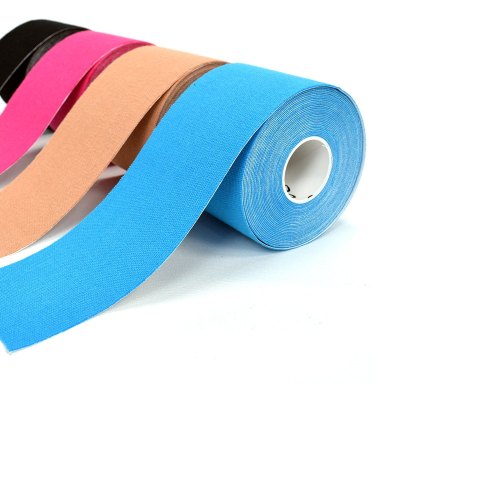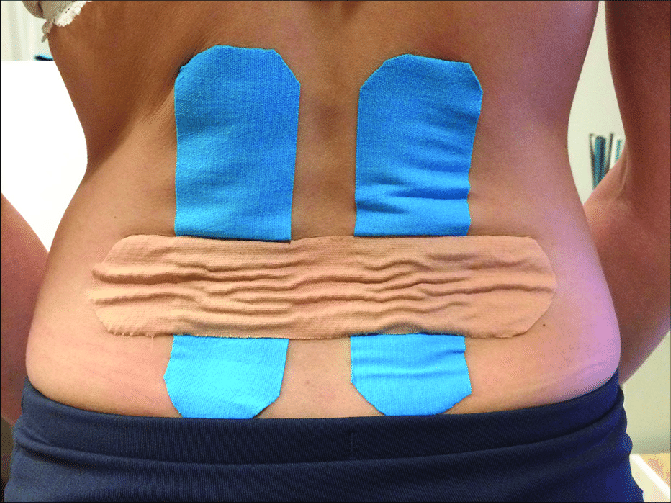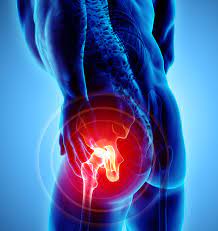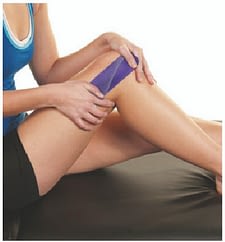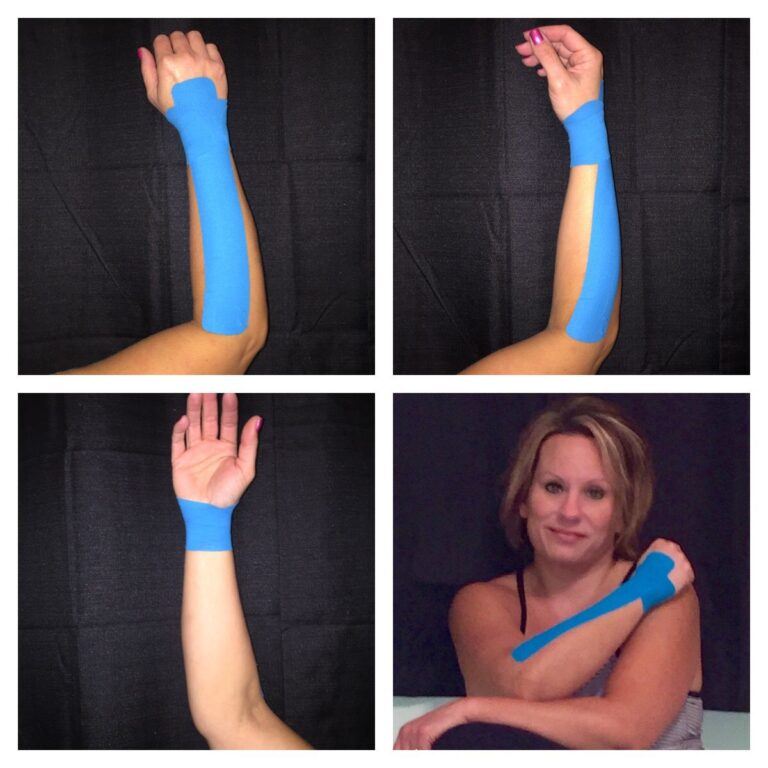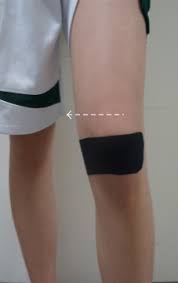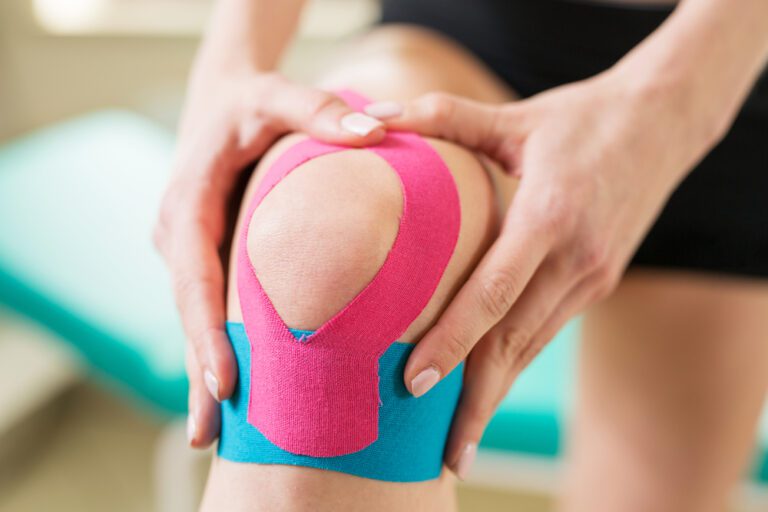Kinesio taping Method instructions
Table of Contents
Introduction :
Kinesio Taping Method is a therapeutic tool utilized by rehabilitation specialists in all programs (pediatric, geriatric, orthopedic, neurological, oncology, and others) and levels of care (acute care, inpatient rehabilitation, outpatient, home care, and Day Rehab).
The idea of using elastic tape to mimic the therapist’s hands was first presented by Dr. Kenzo Kase in the1970s.
Since then it became the modality used in pain management, soft tissue injury, tissue, and joint malalignment, edema, and more.
Kinesiological taping is a rehabilitative cum protective use of stretchable kinesiological tapes to provide reduction of pain, enhance performance, prevent injuries, support the joint, reposition the structure as well as for fascial and ligamentous correction.
It facilitates the healing process while providing the full range of motion with support to the joint’s supportive structures as well as a mobilization effect.
Effects of Kinesio taping :
- stimulate or inhibit muscle function.
- enhances proprioception.
- support joints.
- fascial correction.
- pain relief.
- enhances lymphatic drainage.
Properties of tape :
- made from cotton.
- elasticity capacity 130-140.
- it has been put on its underlying surface in a slightly stretched manner.
- has the capacity to stretch in all directions.
- allow air and water to pass through.
- its hypo-allergic gluing surface will hold for days.
- the complete range of motion will stay possible.
Theory :
Kinesio Taping theory is based on the neurophysiological mechanisms and the effect of mechanical stimuli on various systems in the body:
Central Nervous System (CNS):
Kinesio Tex Tape applied on the skin with varying degrees of stretch creates a mechanical stimulus and activates an afferent pathway to CNS
- Skin: Kinesio Tex Tape applied on the skin with a low degree of stretch changes the density and the concentration of the tissue in the dermis and epidermis.
- This mechanical stimulus converted into electrical impulses is called mechanotransduction and can produce cell movement.
- Kinesio Tex Tape produces pressure and stretches on the skin that may be able to stimulate mechanoreceptors. This stimulus interacts with CNS and modulates pain responses.
- Fascia: the application of Kinesio Tex Tape changes the tension elements in tissues to encourage homeostasis.
- The tension imposed from the tape frees the fascia of any movement limitations through the movement of the skin relative to the target tissue.
Lymphatic and Circulatory System:
- The application of Kinesio Tex Tape facilitates the opening of microvalves due to a dynamic pressure variation as a result of alteration in skin density.
- This decompression activates lymphatics in the dermis and improves lymphatic flow. The end result is tissue inflammation and swelling reduction.
- It is also theorized that lifting the skin detaches filaments that attach the skin to endothelial cells of the lymphatic and capillary beds.
- This is proposed to create channels that allow for lymph to drain, thus reducing swelling and allowing increased blood flow to the area.
How does kt works?
- Kinesio tape is basically an elastic tape that is applied to the skin using the Kinesio Taping Method.
- This therapeutic taping method is supposed to alleviate pain and facilitate lymphatic drainage by microscopically lifting the skin.
- Though athletic trainers have been taping people for years to protect joints and prevent injury, this tape is thinner and more elastic than conventional tape.
- The application, from what I understand, is also different, allowing for greater mobility and skin traction.
- The skin traction is believed to promote an elevation of the epidermis and reduce pressure on the affected area.
- You aren’t supposed to just stick the tape wherever you want, however. There is a method to the taping madness.
- An experienced taper would decide what level of tension would generate an appropriate level of traction on the skin.
- Kinesio Tape allows for proper movement and provides support in the right direction to prevent injuries in athletes or to lift the skin away from the fascia, allowing for increased circulation.
- It could possibly create increased sensory input in injured tissue which can expedite healing.
- It totally made sense to me and sounded like a pretty reasonable modality. Unfortunately, I couldn’t find any real solid scientific evidence Kinesio Tape actually worked.
- All the clinical studies I found had insufficient evidence to back the theory.
- Out of the 10 research papers that were published in the journal of Sports Medicine, there wasn’t enough evidence to support the tape’s use for pain relief and there were inconsistent results for a range of motion too.
- While plenty of people reported positive effects, it seemed unclear if they were founded. Experts have suggested there may be a placebo effect using the tape and they even say we shouldn’t discount that. I mean, if you feel like you have less pain, isn’t that a good thing.
Kinesio taping method concept :
There are two ways to apply kt :
- unstretched: In this case, we stretch the skin of the affected area before the application of the tape.
- this is done by stretching the muscles and joints in the affected area. after application, the taped skin will form convolutions when the skin and muscle contract back to their normal position.
- when the skin is lifted by this technique. the subcutaneous flow of blood and lymphatic fluid is increased.
- stretched: If joints or ligaments are injured, the tape should be stretched before application to the skin.
- the damaged joints or ligaments are incapable of functioning normally and rely on the stretched tape for correction and stabilization.
Benefits of Kinesio taping :
The goals of kinesiology taping are to improve circulation, support muscles, foster healing, and help prevent injury or further injury.
Kinesio tape was originally developed to speed up the recovery time for athletes with injured or overused muscles.
Muscles lose their elasticity when they are injured or overused, and this is what can result in such long recovery times for seemingly small issues.
Many treatments for injuries focus on returning the muscle to its natural shape and position, but this can restrict the movement of the injured body part, which leads to stiffness and slows down recovery time.
By mimicking our muscles’ elasticity, taping can have the opposite effect and actually encourage our muscles to heal faster. It does this in a number of ways:
- Support: Taping can be used to give support to muscles that have been injured or overused, not only relieving some of the immediate pain but also taking stress off that muscle and allowing for faster recovery.
- Adhesive: The adhesive for these tapes is far more complicated than the kind you would find on an everyday plaster. In order for these tapes to work as effectively as possible, it is crucial that they stay in one place. The glue used on these tapes will ensure that they do not move, will stay completely firmly on the body for days, and actually lifts up the skin underneath for breathability.
- Healing: Other than taking stress off and relieving the pain of an injured muscle, taping is designed to encourage lymphatic flow. The lymph system is the system through which a clear liquid (lymph) flows around the body. Lymph carries white blood cells, which fight infection, but also take care of any waste, dead cells, etc that may be found in the body. By encouraging lymphatic flow, recovery time is greatly reduced.
- Encouraging better movement: The way we use our bodies is not always the best way to use them. For example, poor sleeping posture can lead to chronic pain. Similarly, if we learn or train to use certain body parts in certain ways, this can become constricting. Taping our bodies in a certain way can retrain them to move in ways that are more natural, easier, or safer.
- Training/Prevention: With the popularity of taping on the rise, many athletes have realized the potential of using tape to train. All the above benefits remain applicable, only in a way that prevents an injury rather than treating it.
Cutting Different Types of Kinesiology Tape :
1. The “I” Strip :
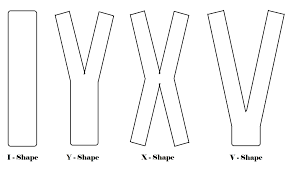
- The “I” strip is the basic building block of kinesiology tape. It is used for muscle facilitation and inhibition, and it can be used to make “X” strips, “Y” strips, the fan, and the lift strip.
- Typically “I” strips are used to support muscles, tendons, and ligaments. They are often used to facilitate your rotator cuff, gluteus muscles, quadriceps, or Achilles tendon.
- The “I” strip can also be used on your low back and middle back to help you maintain proper posture. To make an “I” strip, simply cut off the amount of kinesiology tape you will need.
- Use scissors to round the corners to prevent the tape from being easily pulled off when rubbing against clothing.
2. The “X” Strip:
- An “X” strip is used when kinesiology tape is needed to cover a large area and needs to cross multiple joints. The tabs of the “X” strip crossover sensitive areas such as the back of your knees or front of your elbows.
- This strip is commonly used to facilitate your hamstrings, which cross both your hip joint and the back part of your knee joint.
- To make an “X” strip, cut an “I” strip, and then cut lengthwise from one end of the tape towards the center.
- When you are about halfway through the tape, turn the tape around and cut lengthwise from the other end, leaving about 1-2 inches of tape uncut in the center.
3. The “Y” Strip:
- The “Y” strip is a piece of kinesiology tape that is used to cross sensitive areas of your body such as behind your knee or in the front of your elbow.
- It is also commonly used for applications to control the position of your kneecap as in patellofemoral stress syndrome or a subluxing patella.
- The “Y” strip is typically not as long as the “X” strip.
- A “Y” strip can be made easily by cutting an “X” strip in half.
- If you need a smaller “Y” strip, cut an “I” strip, and then cut the strip lengthwise in half, leaving about 1-2 inches on one end.
4. The Fan :
- The Fan is a type of kinesiology tape used to control swelling of your leg or arm.
- It is commonly used in lymphedema management or for superficial contusions and swelling.
- To make a fan, simply cut an “I” strip, and then make three cuts lengthwise through the tape, leaving about 1-2 inches uncut at one end.
- This creates four small strips of tape that can then be used to fan out over your swollen arm or leg.
5. The Lift Strip :
- The lift strip, commonly referred to as the Band-Aid, is often used to support injured tissues or to treat muscle knots or trigger points.
- The lift strip helps to lift skin and tissues off of sore muscles and trigger points. It is also used to treat superficial bruises. The lift strip is made by cutting a small “I” strip.
- The middle portion of the strip is exposed and then stretched 75-100%. This full stretch is then applied to your body over the injured area.
- Then the smaller end pieces are applied to your body with no stretch, creating a small Band-Aid that lifts the skin and tissues off of your trigger point.
Types of application stretch :
The target tissue should be elongated prior to the tape application. Various amounts of stretch on the tape can be used and it depends on the tissue we choose to affect.
- Ultra light 0-5% (epidermis)
- Super light 5-10% (dermis)
- Paper-off 10-15%(superficial fascia)
- Moderate 25-50% (deep fascia)
- Severe 75% (tendon)
- Full 100% (ligament)
Tape direction and technique used :
Tape direction and technique used are determined based on tissue assessment. Kinesio Taping Method suggests two assessment tools 1. Manual Direction Test (MDT) for the tissue and 2. Manual Direction Test (MDT) for the muscle. MDT for the tissue includes three components 1. glide, 2. decompression, and 4. compression. MDT for the muscle has one component is glide.
Basics of Application :
- Complete the patient’s assessment to identify the most appropriate application. Kinesio Taping Method-specific assessment tools should be included in this process.
- Follow contraindications and precautions when choosing Kinesio Taping Method
- Apply the tape on dry skin, free of oils and lotion
- Remove body hair if possible by trimming or shaving the area
- Follow the tension guidelines
- Round all the edges of the tape to prevent premature peeling
- Avoid touching the adhesive side of the tape after removing the backing as this may decrease the adhesive strength on the skin
- Once the tape is applied, activate the heat-sensitive adhesive by rubbing the surface of the tape for a few seconds
- Reassess to determine post-application results
- Inform the patient to defer activities that cause perspiration for 30 minutes if possible
- Inform the patient to remove the tape if an itching or burning sensation occurs or if the pain increases
- Teach the patient and caregiver how to remove the tape if needed
Provide the patient with informed consent and an information sheet with a description including:
- signs and symptoms of skin irritation and skin allergy.
- instruction on tape removal.
- information on how long to wear the tape.
- physiotherapist contact information.
Indications of taping :
Kinesiology tape has a diverse range of use and application, which has continuously been developed over the years. Kinesiology tapes are used for problems/injuries such as :
- Muscle injury
- Muscle tension
- Joint complaints
- General and non-specific musculoskeletal pain
- Irritations of tendon insertions
- Ligament injuries
- Arthrosis
- Sports injuries
- Back pain
- Poor/incorrect posture
- Lymphedema
- Bruising
- Stabilization
- Injury prevention
- Fascia corrections
- Scar treatment
- Blister prevention
Some examples of specific taping indications are:
- Treatment of pulled muscles and torn muscle fibers
- Runner’s knee + jumper’s knee
- Shin splints
- Inflamed Achilles tendons
- Ankle joint injuries
- Tennis elbow
- Shoulder impingement
- Plantar fasciitis
- Neck strain
- Bruised ribs
Contraindications of taping :
Absolute contraindications are when something should never be done during physical therapy (or any other medical treatment or procedure).
Performing a treatment or procedure on someone when it is absolutely contraindicated may put the patient at risk for injury. Remember the adage first, do no harm.
- Severe allergic reactions to the adhesive tape: Kinesiology tape adheres to your skin.2 If you have a history of a severe allergic reaction to adhesives, you should avoid using the tape.
- Typically, kinesiology tape is worn during athletic activity, but it can also be worn for many days, and placing your skin in contact with adhesives for a long period of time can lead to serious allergic reactions.
- Open wounds: If you have an open wound or surgical incision that is not fully healed, do not use kinesiology tape. The tape could produce a situation where bacteria is introduced into the wound.
- Presence of deep vein thrombosis (DVT): A DVT is a blood clot in one of the deep veins of the arm or leg. Using kinesiology tape near the DVT can increase mobility and blood flow.
- This may cause the clot to become dislodged and may put you at risk for a pulmonary embolism, which may be fatal.
- Infection: If you are showing signs of infection, kinesiology tape should not be used, as it may worsen your condition.
- Altered sensation: If you have uncontrolled diabetes, you may suffer from peripheral neuropathy, a condition where you may have altered sensation in your legs or arms.
- Kinesiology tape should not be used if you have diabetes, since you may not know if the tape is causing a reaction or a problem with your skin.
- Other conditions that cause sensation loss, such as strokes, may also be contraindicated for the same reason.
- Active cancer: If you are currently undergoing treatment for cancer, you should avoid using kinesiology tape, since it is thought that the tape increase circulation, and increasing blood flow and nutrition to a cancerous lesion may be dangerous.
How long can you wear Kinesio tape?
- Once a physical therapist or sports medicine provider positions the tape, it can remain on the skin as long as the adhesive works, usually two or three days.
- The adhesive is strong enough to withstand approved activities, showers, and daily life movements.
- Of course, if the adhesive causes itching, rash, or other types of discomfort, the tape should be removed.
The disadvantage of KT :
- The tape may pull on your skin, causing skin breakdown.
- Lymph node removal Some types of kinesiology tape strips are used for lymphedema and swelling management.
- If you have had lymph node removal, notify your physical therapist so that lymph in your arm or leg is not directed to the area where the node is absent.
How to remove it?
- So presently you’ve got your tape on and you’ve gotten that additional support throughout your chosen sporting activity, it’s time to need it off, so enable the United States to ease the tactic of removing physiology tape for you.
- the foremost effective tip we are going to provide once it involves removing your physiology tape is to peel the skin from the tape, not the tape from the skin.
- But in terms of the actual methodology, 1st ensure you’re removing the tape in an equivalent direction as a result of the expansion of the hair below it, and despite what you’re doing don’t rip the tape off kind of a plaster!
- Start slowly, folding the corners of the sting back bit by bit, guaranteeing that you’re birth the removed tape on the rear of the applied tape, as opposition propulsion the tape on top of and aloof from your arm.
- As you’re scraping the tape, hold your skin down beside your completely different hand and either regulator it or pull it gently among the opposite means of the tape.
- This helps the skin and so the tape to separate heaps expeditiously but with no discomfort.
- If the tape has been applied over a furred region of the body, it helps to maneuver the tape as you are peeling it off, as a result, the pressure helps avoid a lot of pain.
- It’s knowing have shaved the realm before applying the tape but, as this isn’t frequently smart, taking this precaution square measure reaching to be necessary to some.
- want a bit of additional assistance? Apply oil directly onto the tape, rub it in and wait around 10 to twenty minutes before removing it slowly.
- This will facilitate reducing the viscousness of the tape and build it easier to induce obviate.

